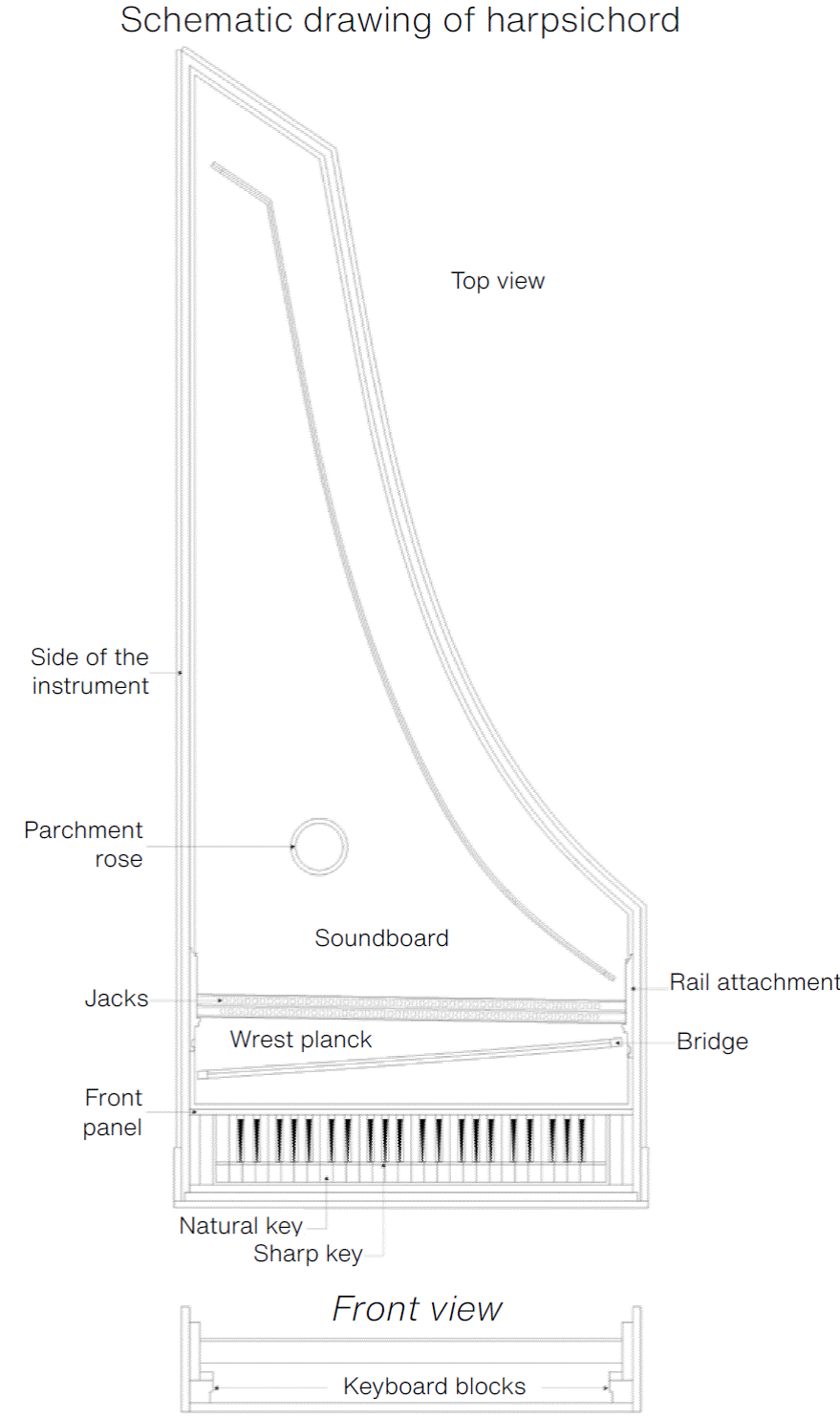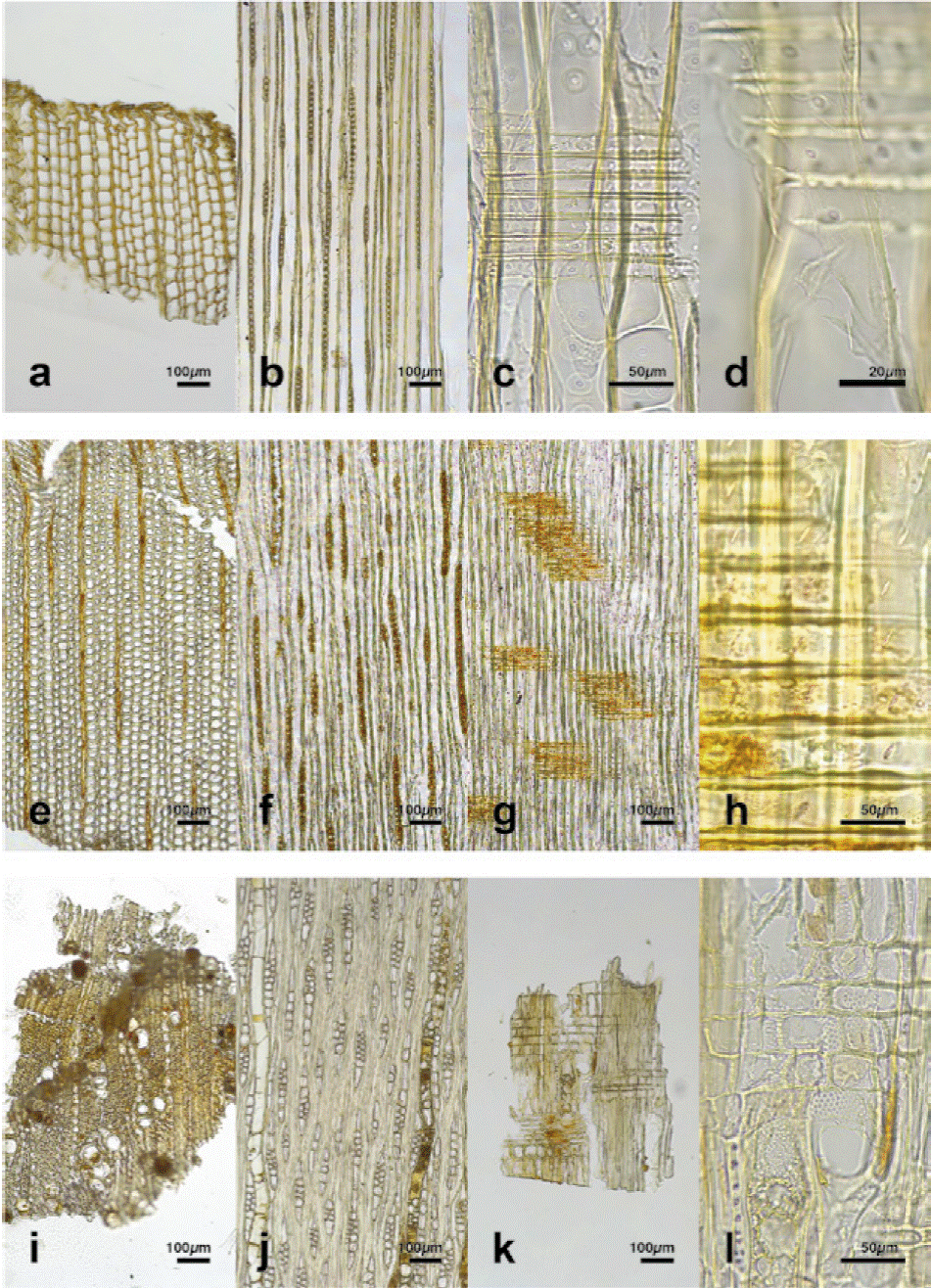Services on Demand
Journal
Article
Indicators
-
 Cited by SciELO
Cited by SciELO -
 Access statistics
Access statistics
Related links
-
 Similars in
SciELO
Similars in
SciELO
Share
Intervención (México DF)
Print version ISSN 2007-249X
Intervención (Méx. DF) vol.14 n.27 México Jan./Jun. 2023 Epub Jan 30, 2024
https://doi.org/10.30763/intervencion.280.v1n27.59.2023
Research Articles
Research into the Wood Species and Geographical Origin of the Harpsichord at the Museo Casa de la Bola, Mexico
1Programa de Maestría y Doctorado en Música Facultad de Música (FAM), Universidad Nacional Autónoma de México (UNAM), México. yareram@hotmail.com
2Departamento de Biología, Universidad Autónoma Metropolitana (UAM), Unidad Iztapalapa, México. aqi@xanum.uam.mx
3Departamento de Biología, Universidad Autónoma Metropolitana (UAM), Unidad Iztapalapa, México. jaramillo@xanum.uam.mx
This article takes a deeper look at the harpsichord in the collection of the Museo Casa de la Bola, a unique example of its kind in Mexico City. Since the origin of the instrument is unknown, we first need to determine its geographic provenance. To obtain this information, a thorough study was carried out to analyze, on the one hand, the structural characteristics of the harpsichord by comparing it against those referenced in the existing literature and, on the other, the microscopic anatomy of the wood by taking samples for the analysis of its cellular structures. The results show that both aspects correspond to Italian harpsichord building traditions during the Baroque period, particularly those associated with the city of Naples.
Keywords: woods; harpsichord; anatomy; construction; Italy
El presente artículo aborda el estudio del clavecín perteneciente a la colección del Museo Casa de la Bola, ejemplar único en la Ciudad de México. Puesto que se desconoce el origen del instrumento, es necesario determinar su procedencia geográfica. Para obtener esta información, se realizó un estudio que analiza, por un lado, las características estructurales del clavecín al compararlas con aquellas referenciadas en la literatura existente y, por el otro, la anatomía microscópica de las maderas mediante la toma de muestras para la revisión de las estructuras celulares. Los resultados muestran que ambos aspectos corresponden con las tradiciones de construcción de clavecines italianos durante el Barroco, particularmente en la ciudad de Nápoles.
Palabras clave: maderas; clavecín; anatomía; construcción; Italia
The harpsichord kept in the Museo Casa de la Bola (Mexico City) is one of the few examples of keyboard instruments from the 17th and 18th centuries preserved in Mexico (Figures 1, 2, and 3). So far, six clavichords, two harpsichords, and one virginal are known to exist in the national territory (Mariño, 2014, p. 40). Of the two harpsichords, only one is in Mexico City: the one currently exhibited as a part of the collection at Museo Casa de la Bola, a building that was the main residence of collector Antonio Haghenbeck y de la Lama from 1942 until his death in 1991.1 Being one of only two harpsichords currently in Mexico, it is a highly valuable specimen for the study regarding building practices of musical instruments during the Baroque period.
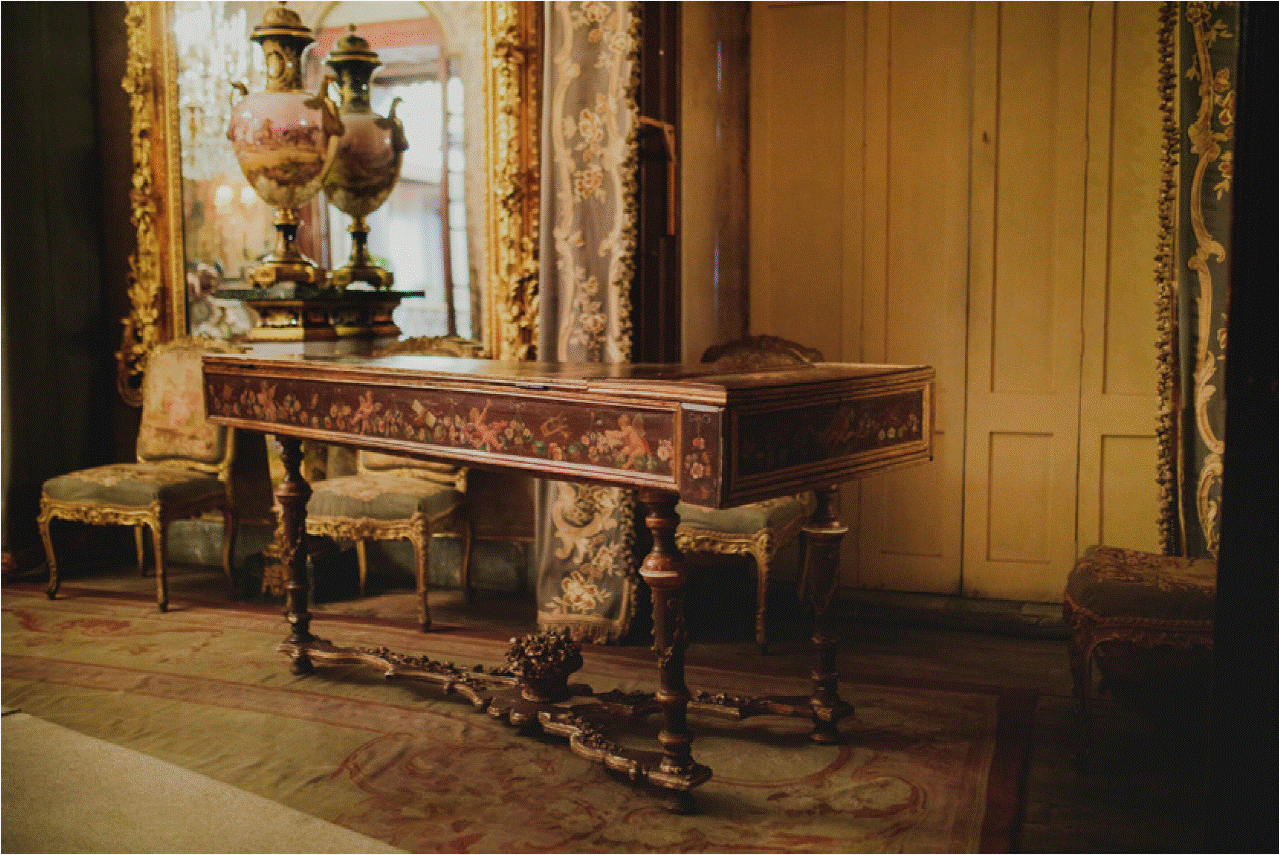
(Photograph: Ramsés Juárez, 2020; courtesy: Museo Casa de la Bola, Fundación Cultural Antonio Haghenbeck y de la Lama IAP’s collection, 2023)
Figure 1 Harpsichord of the Museo Casa de la Bola.

(Photograph: Ramsés Juárez, 2020; courtesy: Museo Casa de la Bola, Fundación Cultural Antonio Haghenbeck y de la Lama IAP’s collection, 2023)
Figure 2 Exterior view of the MCB harpsichord.
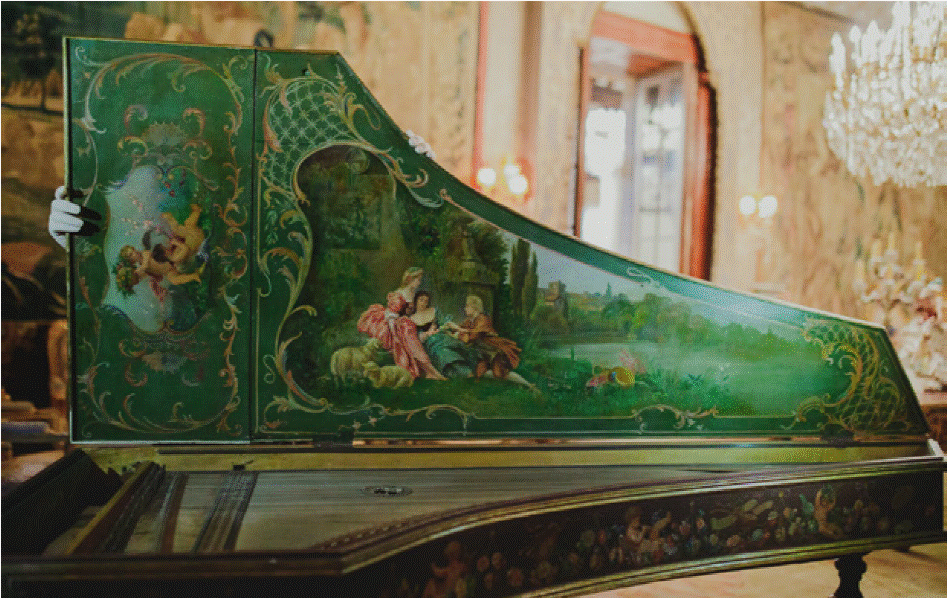
(Photograph: Ramsés Juárez, 2020; courtesy: Museo Casa de la Bola, Fundación Cultural Antonio Haghenbeck y de la Lama IAP’s collection, 2023)
Figure 3 Interior view of the MCB harpsichord.
Haghenbeck’s harpsichord poses several questions due to the absence of typical identifying hallmarks in harpsichords. For instance, makers of these instruments traditionally placed a visible inscription on the nameboard-the front panel above the keyboard-that would include the maker’s name as well as the place and year of its building. Occasionally, this information would be hidden on the sides of the keyboard, one of the keys, or even somewhere in its mechanism. However, no such trace has been found on the MCB harpsichord so far.2
In order to identify exactly where and when the instrument originated, we analyzed its structural and material characteristics. At this point, it is important to note that harpsichord building traditions that emerged in each country have been classified by its designs, structures, and materials into what is known today as national schools. The main ones are Italian, Flemish, French, English, and German (Kottick, 2003, p. 3). According to the most recent research, local traditions within the Italian school have been identified in several cities, each with its own distinctive elements, including the wood species used.
The identification of wood species used in the creation of cultural heritage objects is important to help us confirm the use of local and traditional species in the periods in which they were built and, accordingly, to find out both the biocultural resources of the different periods in which the materials were selected, as well as to determine their relevance, accessibility, and even scarcity in order to be able to conserve them or correctly repair them. The inherent technological adaptation to this process is part of the history of the usage of materials and their impact on the evolution of the building of such important cultural objects as musical instruments.
In order to determine the origin of this harpsichord, we reviewed its structural system, as well as the wood species used in its building.
Background
The terms clavicymbalum, magno cimbalo, and clavicembalo appear in several documents from the courts of Ferrara, Modena, and Padua (Strohm, 1991; Coelho & Polk, 2016; Kottick, 2003). As for the world’s surviving harpsichords, the oldest dates to the 16th century, with at least 40 examples built before 1600 (Koster, 2019, p. 7), with Italian specimens being those made by Vinncentius in 1515 and by Hieronymus Bononiensis in 1521 (Wraight, 1986; Hubbard, 1965).
Italian makers produced two varieties of harpsichords: the first variety consists of instruments with thin sides, which required an external case to protect them, while the sides of the second variety were simply made thicker to simulate the case feature found in the first one. Moreover, specific characteristics distinguish the instruments built from one city to another’s. In the case of Neapolitan harpsichords, we find that the rail support that protects the mechanism3 is held in place by a groove that coincides with a wooden bar attached to the walls of the instrument. Additionally, the keyboards of these harpsichords are removed from the instrument horizontally, as it would be done with a typical drawer. Finally, these instruments often had a decorative parchment rose on the soundboard, in addition to ornamental patterns on the keys (O’Brien, 2009; O’Brien & Nocerino, 2005).
The wood species used for the building of harpsichords, which differ in each country, were usually determined by local availability. The use of cypress wood (Cupressus sempervirens) was exclusive to Italian makers: it is found on the sides of harpsichords as well as in the keyboards, jacks,4 and even the soundboard (Hubbard, 1965, p. 203). Hubbard demonstrates just how frequently it is used: in a sample of 62 Italian harpsichords, 47 had a soundboard made of this wood (Hubbard, 1965, pp. 38-39). The wood used in the soundboard is generally quarter-sawn, except for the harpsichord studied by Jensen (1998), which is made of cypress wood and has a tangential cut (p. 71). This element is important since Italian makers are the only ones who came to use tangential cut wood in their soundboards (Hubbard, 1965, p. 10; Kottick, 2003, p. 73).
Olive wood (Olea europaea), although not very widespread, was used due to its great hardness and attractive appearance. In Italy it came to be used as a structural part of the instrument since, being of local origin, large planks could be easily obtained. Chirico (2009) records its use for repairing the frame of a harpsichord belonging to Cardinal Pietro Ottoboni in 1694 (p. 112). Outside Italy, it was mainly used as veneer for decorative details in marquetry and intarsia (Germann, 2007, p. 136).
Softwoods, such as fir (Abies alba) and spruce (Picea abies), were useful for the soundboard of harpsichords, while hardwoods, such as pear (Pyrus communis) and boxwood (Buxus sempervirens), were useful for the mechanism (Hubbard, 1965, p. 201). Finally, for the building of harpsichords, imported woods were reserved for the decorative elements due to their high cost. Ebony (Diospyros crassiflora), from Africa, is a wood that, because of its hardness and color, is almost always found as key covers.
Although cypress is the signature wood used in Italian instruments, there is a margin of variation and variability depending on the cities where the harpsichords were built. Martin (2012) identified that both the sides and the soundboard of those made in Venice were made from cypress wood, while in Naples and Sicily maple was used for the former and, sometimes, also for the latter (p. 20). This is corroborated by Koster (2019), who also points that Neapolitan harpsichords have maple sides and a spruce soundboard, as opposed to Venetian ones, with cypress sides and soundboard (p. 8). As for Rome and Florence, their harpsichords had cypress sides and spruce soundboard (Martin, 2012, p. 20).
Hypothesis
The construction and structural system as well as the types of wood used in the MCB harpsichord correspond to an instrument of Neapolitan origin.
Methodology
Structural analysis of the MCB harpsichord
A comparative study was made between the visible structural characteristics of the MCB harpsichord and those described in the literature, in order to establish the attribution of the instrument to one of the national schools of harpsichord building and, if possible, to trace its origin back to a specific city (Hubbard, 1965; Kottick, 2003). The general layout of the instrument, the keyboard structure, the rail attachment, the remains of the rose, and the decorative pattern of the keys were all analyzed. As for features not documented in the literature, specimens were sought from which to compare with those found in the structures of the MCB harpsichord.
Study of the microscopic anatomy of wood
Sampling
Samples of 1.5 mm2 were extracted from eight selected areas in each representative structure of the constructive technology: soundboard, nameboard, jack, wrest plank, sharp key, side of the instrument, natural key, and bridge (Figure 4), which were taken to the Laboratorio de Anatomía Funcional y Biomecánica de Plantas Vasculares (Laboratory of Functional Anatomy and Biomechanics of Vascular Plants) at Universidad Autónoma Metropolitana-Unidad Iztapalapa (UAM-I).
Processing
The fragments were deposited in vials with a hydrating solution in PEG 200 at 15%. Samples were mounted on a freezing slide and covered with Tissue Teck® to cut the three typical sections using a Leica® freezing microtome at -20 °C. Transverse, tangential, and radial sections were made and mounted on slides and covered with Entellan Resin®. Photographs were taken to verify the microscopic structure in the sections obtained.
Identification was made by comparing the presence or absence of vessel elements and their cellular contents, such as gums, latex, or crystals; porosity,5 vessel grouping;6 axial7 and radial parenchyma,8 and fibers.9 The analysis of each wood included the recognition of characteristic cells from each genus. Descriptions followed the criteria of the International Association of Wood Anatomists (IAWA, 1989), Kribs (1968), and Schweingruber (1990).
Results
Structural analysis
The physical characteristics of the MCB harpsichord were compared with those presented in the existing literature. The elements of the instrument that were analyzed were its general layout, the keyboard structure, the rail fastening, the remains of the rose, and the decorative pattern of the keys.
The harpsichord is 2.04 m long, 83.8 cm wide, and 18.6 cm deep; it consists of a single keyboard with two sets of strings per note. Along the inside of the sides, a molding simulates the rim of the instrument inside a thicker-walled case. As mentioned previously, in the background of this article, this feature is unique to harpsichords built in Italy.
The next element that yields information about the origin of the instrument is keyboard (Figure 5). Although most of the keys of the MCB harpsichord have been lost, in its present state three natural keys and six sharps remain. The original compass of the instrument is four octaves, with a total of fifty keys, an arrangement that is consistent with the Italian makers of the 17th and early 18th century (Kottick, 2003, pp.133-135). The keyboard is held in place by two blocks that overlap the keyboard frame, meaning that it is only detachable horizontally (Figure 6).

(Photograph: Ramsés Juárez, 2020; courtesy: Museo Casa de la Bola, Fundación Cultural Antonio Haghenbeck y de la Lama IAP’s collection, 2023)
Figure 5 Keyboard of the MCB harpsichord, outside the instrument.

(Photograph: Ramsés Juárez, 2020; courtesy: Museo Casa de la Bola, Fundación Cultural Antonio Haghenbeck y de la Lama IAP’s collection, 2023)
Figure 6 Detail of the left block of the keyboard.
According to the research of organologist Grant O’Brien (n. d.), this is one of the elements that distinguish Neapolitan harpsichords. Additionally, the harpsichord has a wooden bar on the right side where the rail would have been (Figure 7). Although the bar on the left side has been lost, as has the rail, its presence denotes the rail fastening mechanism described in the background section, which is also characteristic of Neapolitan construction.
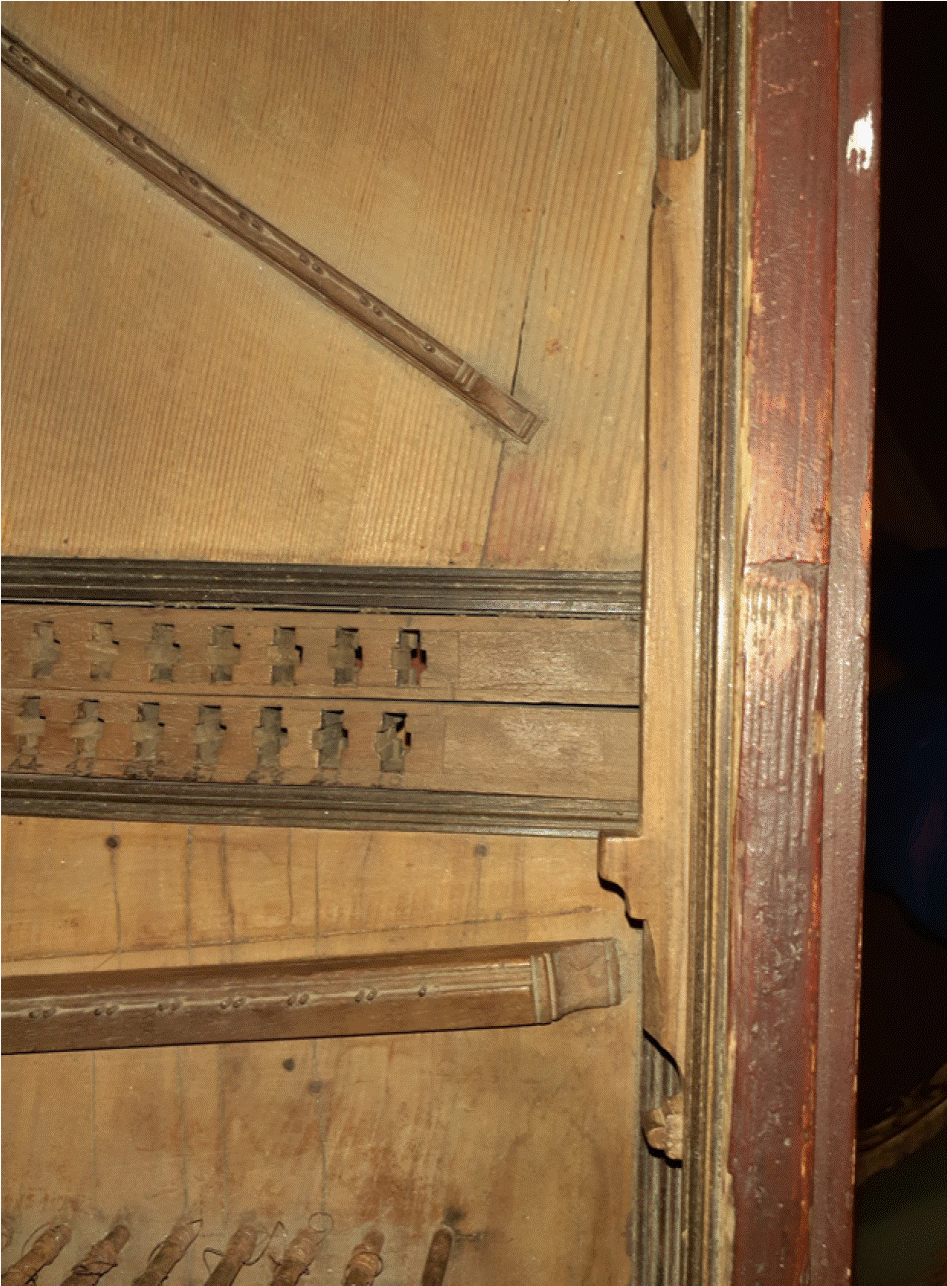
(Photograph: Ramsés Juárez, 2020; courtesy: Museo Casa de la Bola, Fundación Cultural Antonio Haghenbeck y de la Lama IAP’s collection, 2023)
Figure 7 Rail attachment bar of the MCB harpsichord.
The soundboard of the MCB harpsichord preserves the remains of a multi-layered parchment rose (Figure 8). Despite the partial loss, it is still possible to distinguish a quatrefoil structure and traces of the color red in one of the layers. The design of the rosette is particularly interesting since few examples survive with this pattern; in fact, the current state of research has yielded a single rose that bears similarities to that of the MCB harpsichord, and, although incomplete, its resemblance can be observed: It is found on a rectangular virginal by the builder Onofrio Guarracino (1628-c.1698), who was active in Naples.
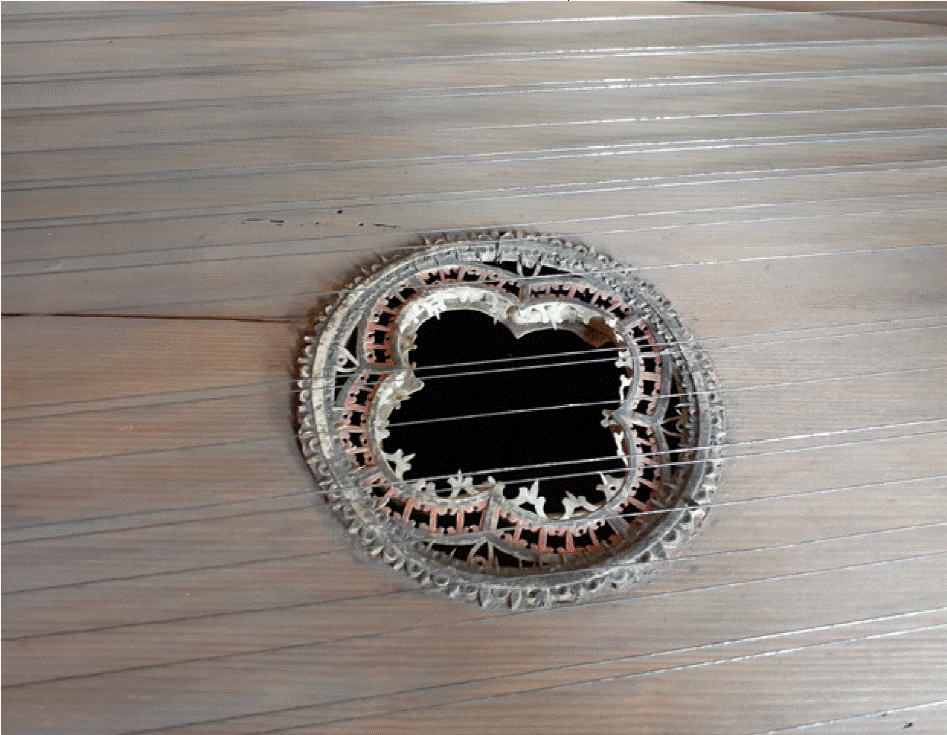
(Photograph: Ramsés Juárez, 2020; courtesy: Museo Casa de la Bola, Fundación Cultural Antonio Haghenbeck y de la Lama IAP’s collection, 2023)
Figure 8 Parchment rose from the MCB harpsichord.
The sharps have a particular decorative pattern that incorporates dark wood-ebony -and a light material -ivory or bone -in a triangular design. Although there are several harpsichords with richly ornamented sharps, this type of triangular pattern is notoriously rare. Fortunately, it has also been identified on an instrument by the Neapolitan builder Ignazio Mucciardi. Both, the rose and key pattern of the MCB harpsichord, are consistent with the findings of O’Brien (n. d.), who states that harpsichords built in Naples typically carried elaborately detailed parchment roses as well as sharps with distinctive decorative patterns.
Anatomical identification of woods
Soundboard
It is made from wood of the genus Picea sp., possibly P. abies; it belongs to the Pinaceae family, with the common name: spruce.
Microscopic anatomical description: Earlywood and latewood tracheids are present, growth ring boundaries distinct. Axial parenchyma is not observed, pits in cross-field are piceoid, sometimes taxodioid (Figure 9 a-d).
Nameboard
It is made from wood of the genus Cupressus sp., possibly C. sempervirens; it belongs to the family Cupressaceae, with the common name: cypress.
Microscopic anatomical description: Earlywood and latewood tracheids are present. Axial parenchyma is present, ray lumens and cupressoid pits are present in cross-field and some axial parenchyma cells contain resins (Figure 9 e-h).
Wrest Plank
It is made from wood of the Olea genus, possibly O. europaea; it belongs to the family Oleaceae, with the common name: olive tree.
Microscopic anatomical description: Wood diffuse-porous, pores are very abundant and small, contain yellow gums and tyloses. Vessel elements are solitary and radial multiple up to eight. Alternate bordered intervessel pits are present and vessel-ray pits are similar. Simple perforation plate is present. Marginal Axial parenchyma in concentric bands, apotracheal is scanty diffuse and scanty diffuse in sparse aggregates, paratracheal scanty to vasicentric. Rays, mostly biseriate heterogeneous with one to three rowed square cell tails and the body formed by procumbent cells; they contain yellow vessel-like gums and prismatic crystals. Libriform fibers with simple pits (Figures 9 i-l).
Natural key
It is made from Buxus sp. wood, belonging to the Buxaceae family, with the common name: boxwood.
Microscopic anatomical description: Wood diffuse-porous, pores are very abundant and very small. Vessel elements are mainly solitary and rarely radial multiple, contain few dark brown gums at their lumina. Alternate bordered intervessel pits are present. Scalariform perforation plate. Apotracheal axial parenchyma diffuse and diffuse in aggregates. Rays are mostly triseriate; uniseriate and four-seriate can rarely be seen; heterogeneous; the body formed by procumbent cells and the tails by one or two rows of square cells, without deposits at lumina. Fibers with distinctly bordered pits (Figure 10 a-c).

(Photographs: Alejandra Quintanar- Isaías & Ana Teresa Jaramillo-Pérez, 2021; courtesy: Laboratory of Functional Anatomy and Biomechanics of Vascular Plants, UAM-I)
Figure 10 a-c. Buxus sp. (boxwood); b. Heterogeneous rays characteristic of this genus; d-i. Juglans sp.; a. Axial parenchyma; e and h. Homogeneous rays characteristic of this genus.
Sharp key and bridge
It is made from Juglans wood, possibly J. nigra; it belongs to the Juglandaceae family, with the common name: walnut.
Microscopic anatomical description: Wood ring-porous to semi-ring-porous; pores are not abundant across the growth ring. Vessel elements are solitary and radial, up to three, contain dark brown gums and tyloses. Alternate bordered intervessel pits are present, and vessel-ray pits, similar. Simple perforation plate present. Marginal axial parenchyma, marginal, diffuse, and diffuse in aggregates; scanty paratracheal and the vasicentric is formed by a single-cell-wide row, with dark brown gums at their lumina. Rays, mostly triseriate, a few up to four series can be seen; homogeneous; the body formed by procumbent cells which contain dark brown gums similar to those at vessels and axial parenchyma lumina. Fibres with minutely bordered pits (Figure 10 d-i).
Jack
It is made from wood of the genus Pyrus, possibly P. communis; it belongs to the Rosaceae family, with the common name: pear tree.
Microscopic anatomical description: Wood diffuse-porous, small and abundant pores with reddish brown gums. Solitary vessel elements, helical thickening present, alternate bordered intervessel pits present and vessel-ray pits are similar. Simple perforation plate. Apotracheal axial parenchyma, diffuse in aggregates; paratracheal parenchyma scanty with deposits and prismatic crystals. Rays width is one to three cells, homogeneous; body formed only by procumbent cells with dark brown gums and prismatic crystals in their lumina. Very thick-walled fibrotracheids with distinctly bordered pits (Figures 11 a-c).
Side of the instrument
It is made from Populus wood, belonging to the Salicaceae family, with the common name: poplar.
Microscopic anatomical description: Wood diffuse-porous to semi-ring porous; pores are generally few across the growth ring. Solitary and radial multiple vessel elements up to two to three, occasionally five are counted, with no gums or other ergastic contents. Alternate bordered intervessel pits are present. Vessel-ray pits with much reduced borders to apparently simple. Simple perforation plate present. Apotracheal axial parenchyma diffuse, scanty, without ergastic deposits. Rays uniseriate, long homogeneous, the body formed by procumbent cells, without ergastic deposits. Fibers with simple pits (Figure 11 d-f).
Discussion
The two transcendent factors in the study of the origin of the MCB harpsichord are related to available and tested wood species in technological and acoustic features of the building of musical instruments; particularly, those like the one we are dealing with here. Moreover, the manufacture and structure of this instrument belong to the group of harpsichords made in Naples towards the end of the 17th and beginning of the 18th century, which differ from those manufactured in other Italian cities with specific dispositions and mechanisms.
The wood of the soundboard of the MCB harpsichord belongs to the Picea genus, possibly P. abies, widely used for soundboards in fretted and plucked string instruments, so its presence is in accordance with the tradition and experience of working with this material. The nameboard, made of Cupressus wood, stands out for being light and easy to work with, characteristics required for this section of the instrument. The wrest plank is made of olive wood, which was selected for its aesthetic characteristics, such as its grain, and because it is not prone to deterioration, in addition to meeting the required mechanical resistance standards. The natural keys made of boxwood are traditional due to their resistance properties: it is widely used for polychrome sculpture and in wind instruments such as the bagpipes flutes. Also, its use in the keyboards of Italian harpsichords is extensively documented (Kottick, 2003, p. 75).
The sharp keys and the bridge are made of walnut, which coincides with what the documents say on the use of this wood in this part of the instrument. This wood is easy to work with, resistant, and of high aesthetic quality due to its color and grain (Kottick, 2003, p. 167).
Pyrus wood was used to make the jack; although it has a light to medium density, it was selected for its mechanical strength required for the ascent and descent mechanism.
Finally, the side of the instrument was made with Populus or poplar wood, which, although very light-and good to work with-, strengthens the structure. Its use in this instrument is particular because of its low resistance to decay; however, it is possible that the maker selected it to allow for a lighter weight. In addition, poplar is also known to be a highly prized wood for furniture.
Conclusions
The results obtained from the comparison of the structural characteristics of the MCB harpsichord manage to identify its correspondence with the distinctive elements of other Italian harpsichords. Therefore, it can be determined that the instrument was built in Italy, possibly at the end of the 17th century. Additionally, its method of keyboard removal, as well as its rail fastening mechanism, point to a probable origin in the city of Naples.
Finally, the microscopic identification performed on the woods used in its construction is consistent with the types of wood used in Italian harpsichords of the period. In sum, the woods used throughout this instrument are of Mediterranean origin, which corroborates the biocultural use of the species for the building of musical instruments during the Baroque period.
Acknowledgments
We are grateful to María de Lourdes Monges Santos, director of the Casa de la Bola Museum, for her kind permission to study the harpsichord, and to Emilia Moysen and Dr. Fernando Herrera for their invaluable help throughout all the work carried out on site.
This study was partially supported by the divisional project “Functional relationships of xylem and phloem in the soil-plant-atmosphere continuum in Mexican tree and shrub species of forestry importance. “Phase IV”, of the Biology Department of the Universidad Autónoma Metropolitana (UAM, Autonomous Metropolitan University), as well as by the National Grants Program for Postgraduate Studies of the Consejo Nacional de Ciencia y Tecnología (Conacyt, National Council for Science and Technology).
REFERENCES
Chirico, T. (2009). New Information about Harpsichords and Harpsichord Makers Employed in Rome by Cardinal Pietro Ottoboni and His Father Antonio. The Galpin Society Journal, 62, 101-115. [ Links ]
Coelho, V. y Polk, K. (2016). Instrumentalists and Renaissance Culture, 1420-1600: Players of Function and Fantasy. Cambridge University Press. [ Links ]
Coster, J. (2019). History and Construction of the Harpsichord. En M. Kroll (Ed.), The Cambridge Companion to the Harpsichord (pp. 2-30). Cambridge University Press. [ Links ]
Germann, S. (2007). Decoration. En I. Kipnis (Ed.), The Harpsichord and Clavichord: An Encyclopedia (pp. 116-146). Routledge. [ Links ]
Hubbard, F. (1965). Three Centuries of Harpsichord Making. Harvard University Press. [ Links ]
IAWA. (1989). List of Microscopic Features for Hardwood Identification. IAWA Bulletin, 10(3), 219-332. [ Links ]
Jensen, D. (1998). A Florentine Harpsichord: Revealing a Transitional Technology. Early Music, 26(1), 70-85. [ Links ]
Koster, J. (2019). History and Construction of the Harpsichord. En M. Kroll (Ed.), The Cambridge Companion to the Harpsichord, (pp. 2-30). Cambridge University Press. [ Links ]
Kottick, E. (2003). A History of the Harpsichord. Indiana University Press. [ Links ]
Kribs, D. (1968). Commercial Foreign Woods on the American Market. Dover. [ Links ]
Mariño, E. (2014). Estudio de la Tecnología, Historia y Significado Cultural del Clavicordio del Museo Nacional del Virreinato, Tepotzotlán, Estado de México [tesis de licenciatura]. Escuela Nacional de Conservación Restauración y Museografía “Manuel del Castillo Negrete”. [ Links ]
Martin, D. (2012). The Art of Making a Harpsichord. Robert Hale Limited. [ Links ]
O’Brien, G. (2009). The Single-Manual Italian Harpsichord in the Royal College of Music, Londres, Cat. No. 175: An Organological Analysis. The Galpin Society Journal, 62, 55-99 y 194-195. [ Links ]
O’Brien, G. (s. f.). Characteristics of the Neapolitan School of Harpsichord Building. Recuperado el 4 de junio de 2020, de http://www.claviantica.com/Characteristics.htm [ Links ]
O’Brien, G. y Nocerino, F. (2005). The Tiorbino: An Unrecognised Instrument Type Built by Harpsichord Makers with Possible Evidence for a Surviving Instrument. The Galpin Society Journal, 58, 184-208, 232-235. [ Links ]
Schweingruber, F. (1990). Anatomy of European Woods: An Atlas for the Identification of European Trees, Shrubs and Dwarf Shrubs. Paul Haupt. [ Links ]
Strohm, R. (1991). Die private Kunst und das öffentliche Schicksal von Hermann Poll, Erfinder des Cembalos. En M. Fink (Ed.), Musica privata. Die Rolle der Musik im privaten Leben. Festschrift zum 65 (pp. 56-66). Geburtstag von Walter Salmen. Musikleben des Spätmittelalters in der Region Österreich. [ Links ]
Wraight, D. (1986). Vincentius and the Earliest Harpsichords. Early Music, 14(4), 534-538. [ Links ]
1Antonio Haghenbeck y de la Lama (1902-1991) was heir to the fortune and real estate business of the Haghenbeck family after the death of his father. He spent his entire life devotedly collecting art pieces and antiques, many of which he acquired during his journeys across Europe. He was a man with great philanthropic and animal welfare interests, which is why he created two private assistance foundations, one for the care of animals and the elderly, and the other for the preservation of three house museums (including the Casa de la Bola Museum) open to the public. He established that, after his death, his assets would be used to maintain both foundations in operation
2For the purposes of this article, our object of study will be referred to as the MCB harpsichord according to the acronym of the Museo Casa de la Bola.
3The rail is a piece of wood that prevents the harpsichord mechanism from slipping out of place. The mechanism of the instrument is made up of a series of moving parts called jacks.
4The jacks are the parts of the mechanism that transmit the vertical movement from the keys and allow a plectrum (pick) to strum the strings, thus causing them to vibrate.
5It refers to the spatial organization of vessel elements (water and mineral conducting cells) in a growth ring. Porosity may be circular when two vessel sizes are present, the largest at the beginning of the ring, or diffuse, when different sizes are randomly distributed within the ring.
6Clustering occurs among two or more vessels radially or tangentially arranged to the circumference of the growth ring.
7Reserve cells that are organized in various aesthetic and functional patterns surrounding the capillaries (paratracheal) or away from them (apotracheal) and arranged parallel to the trunk axis.
8Reserve cells that are organized in various aesthetic and functional patterns arranged perpendicular to the axis of the trunk.
Received: September 30, 2022; Accepted: February 22, 2023; Published: September 30, 2023











 text in
text in 


